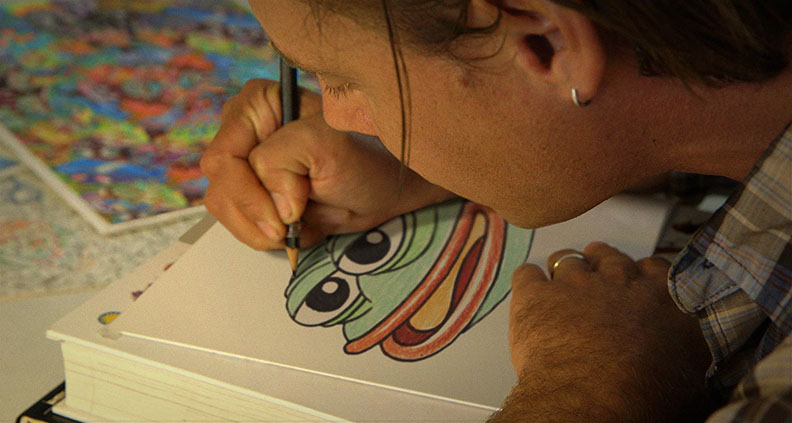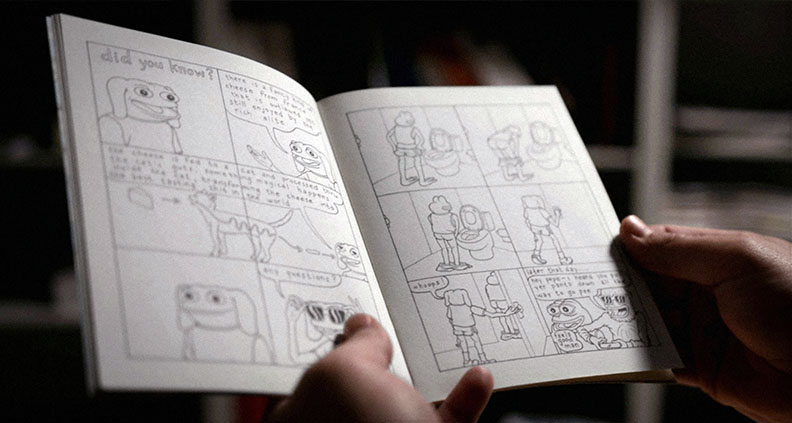From Meme to Mayhem: ‘Feels Good Man’ Doc Seeks to Explain Pepe the Frog
The world, of course, has always been a weird place. But the last four years have been particularly weird, a seemingly cosmically unbalanced string of events ranging from the merely deeply absurd to the existentially devastating. And you know who started it all? Pepe the Frog. Or at least that’s how it sometimes seems, because even if you don’t recognize the underground cartoon character’s name, you’ll surely recognize his face—smirking, green, stoned eyes letting you know that whatever he may be doing at the moment, “Feels good, man.” Pepe: an icon of internet memedom, whose meaning and evolution are profoundly muddled.
Long story short: the original, innocuous Pepe was originally created by San Francisco cartoonist Matt Furie for his comic Boys Club in 2005. Once digitized, the simple graphic image of Furie’s smiling stoner amphibian quickly lost its original context as it was widely shared across a variety of online communities, tweaked and appropriated toward a variety of purposes, before ultimately finding its most profound foothold as a symbol of the burgeoning “alt-right” movement in 2016—a movement ultimately culminating in the election of Donald Trump.
The Pepe phenomenon raises a variety of questions—is it possible to reclaim an image from hate-symbol status? How has this surreal turn of events impacted the soft-spoken Furie and his family? Why does Pepe resonate so deeply with people?—many of which are addressed by first-time filmmaker Arthur Jones in his new documentary Feels Good Man, which above all seeks to provide some much-needed context for the frog and his continuing tranformation.
We recently spoke to Jones as well as Feels Good Man producers Giorgio Angelini, Caryn Capotosto and Aaron Wickenden (also one of the film’s editors) about film, which will be available to rent on SVOD platforms beginning this Friday. Here’s the conversation:
‘FEELS GOOD MAN’

Watching the film, I recalled other documentaries about the internet and how those films often struggled to be visually dynamic. Obviously that wasn’t an issue with this project. Can you talk a little bit about developing the visual approach of the film?
Jones: I’ve watched all those documentaries about the internet and social media, and they’re all fine as far as journalism. But we really wanted this to feel like a movie. We wanted the internet to feel like it had its own energy. So we did that in a couple different ways. The first is, we had a pretty intense archival process going into the material from all over the internet. And then there was the world of motion graphics and the world of cartoons. And the world of cartoons is really where we tried to canonize Matt’s artwork so that people could understand the context. One of the reasons [Pepe] became a meme is because people didn’t know where he came from, so we really wanted people to understand that. We wanted [Furie’s original artwork] to have as much or even more weight than all of the internet information. We also sought to make the internet feel very claustrophobic. Imagine you’re someone looking at 4chan in a dark room and your entire field of vision is the screen and it’s your only means of expression.
Wickenden: What Arthur says also reminds me of [sound mixer/sound editor] Lawrence Everson’s contribution to the film.
Angelini: Yeah, when we spoke to Lawrence the main mission was, how do we make this otherwise sterile experience really come to life onscreen. He [Lawrence] really took that prompt and ran with it in a creative way. The magnum opus of that is the Hillary Clinton speech, where the kids on 4chan are feverishly typing back and forth about what they’re going to do to prank her. Lawrence’s take on that was basically to create a cacophony of clicking sounds, so that it almost felt like a fire burning. When Lawrence shared with me the first 30 minutes of work he’d done, I was crying. It was so creative in this way I wasn’t expecting.
Jones: One of the things our team went out and captured in the field was a number of scenes of Matt and his daughter taking in the information together. There was something really deeply poignant about that—seeing the two of them processing this information—that made you understand on a deeply human level Matt’s humanity. He wasn’t just this person in isolation, but a person with a family and a background and relationships. So that was another aspect of the ways in which we were trying to amplify the ways in which the hijacking of his character was overflowing into his life and space.

What was the process like going through and curating all of these different Pepe the Frog images?
Jones: The thing about 4chan is that it’s a place where people are constantly generating new memes. People take Pepe and remix him and it’s sort of alive, back and forth. 4chan is also kind of obsessed with its own history; there are places where you can download entire sets of archives of 4chan posts from a specific period of time. So I started to do that, and then all of our editors would each bring in their own archival Pepe images as well. And we sought to organize the story through the emotionality of the character.
Wickenden: When you interact with Pepe on the internet, he’s so many different things simultaneously. Narratively, one of the things we really set out to do was show the trajectory of that evolution, the taking of the character and all of those different evolutions, to sort of make sense of that transformation. One of the things we found as we were working is that it became very easy to kind of go down a stream of clicks until you’re very far away from Pepe’s story. So on the edit side of things we came up with the phrase “the thin green line,” which became out tongue-in-cheek mantra to keep bringing everything back to Pepe.
Talk about some of the people you interviewed for the film. You have some of Matt’s family and peers, but also people like the 4chan user and Trump’s former digital communications director.
Capotosto: Arthur can speak to this, this idea of having parameters set on the characters you meet that are 4chan and allowing them only a certain amount of screen time in order to not give them too much of a pulpit while at the same time having them tell their story authentically, from their perspective.
Jones: There were a number of documentaries coming out when we were making [the film] that featured the provocateurs of the alt-right, and we realized that those guys were weaponizing people like Mills [a 4chan “shitposter” profiled in the film]—they were taking the stuff that Mills was into and cynically building a coalition around that, exploiting this kind of iconography to build out the kind of base they were going for.
Angelini: The film was conceived out of events like Charlottesville, where we were all feeling sort of raw that the media seemed to be giving a lot of coverage to who we felt were the wrong kind of people, giving them a platform to spread their hateful message. But at the same time as a film, we really wanted to really give context as to how all of this operates and why someone like Mills spends an inordinate amount of time in his basement—things that society really needs to interrogate and understand, and less so the garbage they’re saying.

How did you determine what range of voices would need to be in the film in order for you to tell the complete story?
Jones: At the beginning of the process we sort of cast a wide net. The first set of interviews I did on my own were with Matt and his family and [artists] Lisa Hanawalt and Emily Heller. We did talk to a lot of academics and journalists, but as we were editing a lot of those voices started to fall away because, frankly, they weren’t as compelling. We wanted the film to feel like you as the viewer are learning things for yourself. It was a film with so many different pieces, ultimately its up to the audience member to have those pieces to connect themselves.
Wickenden: We even filmed with some characters that didn’t make the cut. We filmed with a young artist in Russia—she takes these images of Pepe and makes these incredible oil paintings. It was a great scene. She’s got this little pug dog and it would get green paint all over it. But we couldn’t get it to fit into the edit because ultimately, the interview subjects had to support this narrative of Pepe’s transition and transformations, and she was adjacent to that.
Can you talk a little bit about what it was like to pitch this film and now, what it’s like trying to put it out during quarantine?
Capotosto: In the beginning it was a difficult story to explain to people and what our vision for it was going to be, just to get funding to get this thing made. It was just so mind-blowing, the story, but the parts of the story were very hard to explain what it would look like and how these characters would interact, and how impactful the film could actually be given our current circumstances.
Jones: In the end we were happy we weren’t able to pre-sell it with someone, because we were able to have final cut ourselves and keep it as a DIY project among friends. I’m really happy with the way it all turned out the way it did, because it was such an interesting collaboration between all of us.
Capotosto: The pandemic hit and we were only managed to get three festivals in before all the shutdowns. So we decided somewhere in the middle of that to sort of go for the gold ourselves and self-release it with sort of the support of PBS and Independent Lens, which is quickly putting it out in every market on October 19. It’s going to have the right amount of eyeballs on it right when we need them to see it, so that’s working out in a really amazing way for us.
Angelini: When we dropped the trailer, I think we were pretty aware there was going to be a certain response from a certain group on the internet. And you can see that in our YouTube comments. But when I started our TikTok account, it just blew up overnight. All these Gen Z kids, they get it. The story of Pepe is deeply personal in all the right ways. It’s a story about how the internet they grew up with got coopted by evil forces. The see, in Pepe’s transformation, hopefully, back to good their own story. That’s super-empowering and encouraging.
Feels Good Man will be released on SVOD this Friday, September 4 and will be broadcast as part of the PBS docu-series Independent Lens on October 19. To learn more about the film, visit its official website.
Film Independent promotes unique independent voices by helping filmmakers create and advance new work. To become a Member of Film Independent, just click here. To support us with a donation, click here.
More Film Independent…
(Header photo credit: Kurt Keppeler)